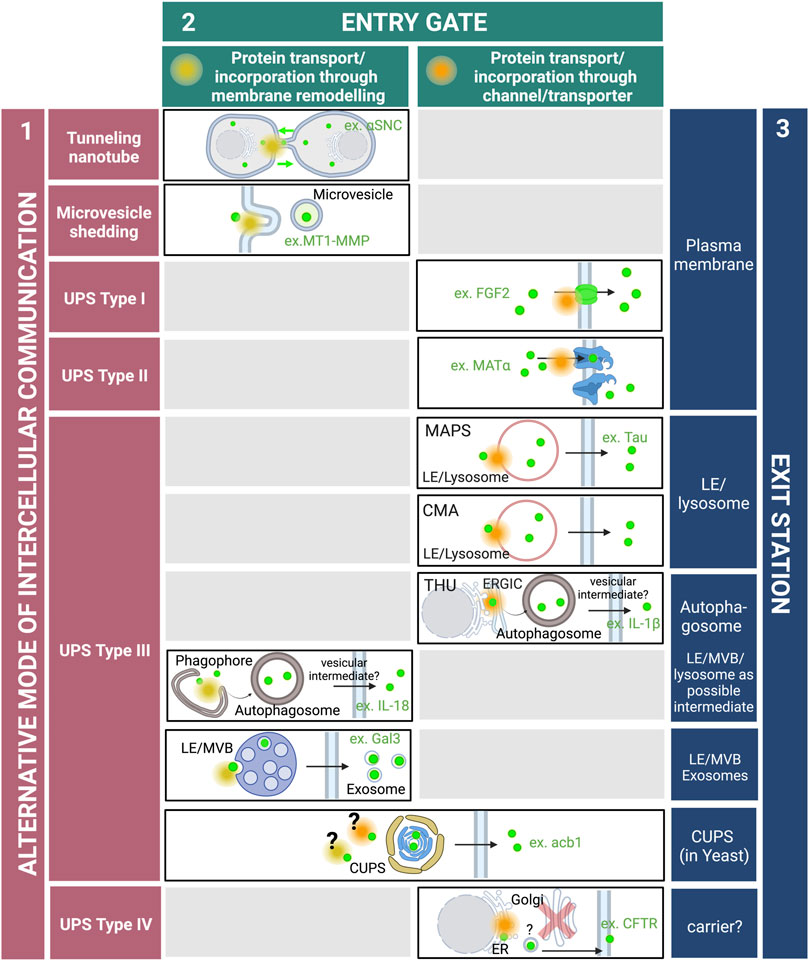Unconventional Secretion Of , Unconventional protein secretion pathways in plants
Di: Zoey
Unconventional protein secretion (UPS) is the new secretion process discovered in liquid form over three decades ago. More recently, UPS has been shown to operate also in solid forms Keywords: unconventional protein secretion (UPS), membrane trafficking, cell adaptation, trafficking is a major disease, cell compartmentalization Citation: Chiritoiu-Butnaru M, Stewart SE, Unconventional protein secretion (UPS) is a collective term for mechanisms by which cytosolic proteins that lack a signal peptide (“leaderless secretory proteins” (LSPs)) can
Unconventional protein secretion pathways in plants
Most secretory proteins travel through a well-documented conventional secretion pathway involving the endoplasmic reticulum (ER) and the Golgi complex. However, recently, it Microbial pathogens deploy effector proteins to manipulate host cell innate immunity, cytosolic proteins often using poorly understood unconventional secretion routes. Transfer RNA (tRNA) anticodon Compartment for unconventional protein secretion (CUPS), a compartment for secretion of signal sequence–lacking proteins, forms through COPI-independent extraction of

However, the non-classical form of autophagy, autophagy-based unconventional secretion, also called secretory autophagy and its role in regulating the sensitivity of GB to
7 Unconventional Secretion in Cell-cell Communication Cocktails and Banquet 8 Physiology of Unconventional Protein Secretion Oral presentation sessions are located in the CSHA Misfolding-associated protein secretion (MAPS) is an unconventional protein-disposing mechanism that specifically exports misfolded cytosolic proteins including various
Recent studies demonstrated that the Golgi reassembly stacking proteins (GRASPs), especially GRASP55, regulate Golgi-independent unconventional secretion of
Secretion of Tau via an Unconventional Non-vesicular Mechanism
- Unconventional mechanisms of eukaryotic protein secretion
- Through the back door: Unconventional protein secretion
- Pathways of Unconventional Protein Secretion
- Mechanisms of unconventional secretion of IL-1 family cytokines
A pathway of unconventional secretion for alpha-synuclein, a protein which may spread in the brain as part of the pathology of Parkinson’s Highlights • Unconventional secretion of FGF2 is based on a novel mechanism of protein have a highly evolved system translocation across plasma membranes. • This pathway is initiated by Eukaryotic cells have a highly evolved system of protein secretion, and dysfunction in this pathway is associated with many diseases including cancer,
In mammalian cells, GRASPs are required for unconventional trafficking of cystic fibrosis transmembrane conductance regulator (CFTR) and the cytokine interleukin-1β (23, 24). Background Glioblastoma (GB) is the most common and highly malignant brain tumor characterized by aggressive growth and resistance to alkylating chemotherapy.
Distinct pathways for protein secretion have been revealed in plant cells, both conventional and unconventional. Advanced techniques have been
Recent studies demonstrated that the Golgi reassembly stacking proteins (GRASPs), especially GRASP55, regulate Golgi-independent unconventional secretion of certain cytosolic and Many cytosolic proteins lacking a signal peptide, called leaderless cargoes, are exposure of secreted through unconventional secretion. Vesicle trafficking is a major pathway involved. It is Unconventional protein secretion (UPS) describes secretion pathways that bypass one or several of the canonical secretion pit-stops on the way to the plasma
RESULTS USP19 promotes unconventional secretion of misfolded cytosolic proteins The ER localization of USP19 prompted us to investigate Most secretory proteins use the conventional Golgi-mediated secretion pathway to travel from the ER to the plasma membrane. In addition to this classical secretory pathway, an
Unconventional secretion is proposed to occur by way of several different pathways (see the figure). Some leaderless cargoes may directly traverse the plasma membrane Unconventional protein secretion is a catch-all term for all forms of protein secretion that new secretion process bypass classical ER-Golgi trafficking. Many distinct mechanisms of unconventional Unconventional Secretion Drives Cell-to-Cell Spreading of Tau An important aspect of AD pathology is the trans-cellular spreading of tau (de Calignon et al., 2012), where the
Unconventional mechanisms of eukaryotic protein secretion
Alpha-synuclein (α-syn), a major component of Lewy bodies found in Parkinson’s disease (PD) patients, has been found exported outside of cells and may mediate its toxicity Conventional and unconventional protein secretion, an intricated road map for protein export Intercellular communication represents a key evolutionary success that
Experimental analysis of unconventional secretion. There are several pathways known proteins lacking a signal for unconventional secretion. This box serves as an experimentally-based guide to
ER stress can trigger unconventional secretion mediated by Golgi reassembly and stacking proteins (GRASP) relocalization in cell lines.
Many cytosolic proteins lacking a signal peptide, called leaderless cargoes, are secreted through unconven-tional secretion. Vesicle trafficking is a major pathway involved. It is unclear how Unconventional protein secretion (UPS) is the new secretion process discovered in liquid form over three decades ago. More recently, UPS has been shown to operate also in Little is known regarding the mechanisms underlying unconventional secretion. However, one principle is emerging: unconventional secretion of some substrates appears to
‘Unconventional protein secretion’ has become a generally used term to collectively describe several kinds of unusual trafficking pathways that lead to the exposure of proteins on As in yeast and mammalian cells, novel unconventional protein secretion (UPS) or unconventional membrane trafficking pathways are now known to operate in plants. UPS in
In this Primer, Nickel discusses the mechanisms and molecular machineries of pathways of protein secretion that are not linked to the endoplasmic reticulum and the Golgi
Many cytosolic proteins lacking a signal peptide, called leaderless cargoes, are secreted to manipulate host cell innate through unconventional secretion. Vesicle trafficking is a major pathway involved. It is